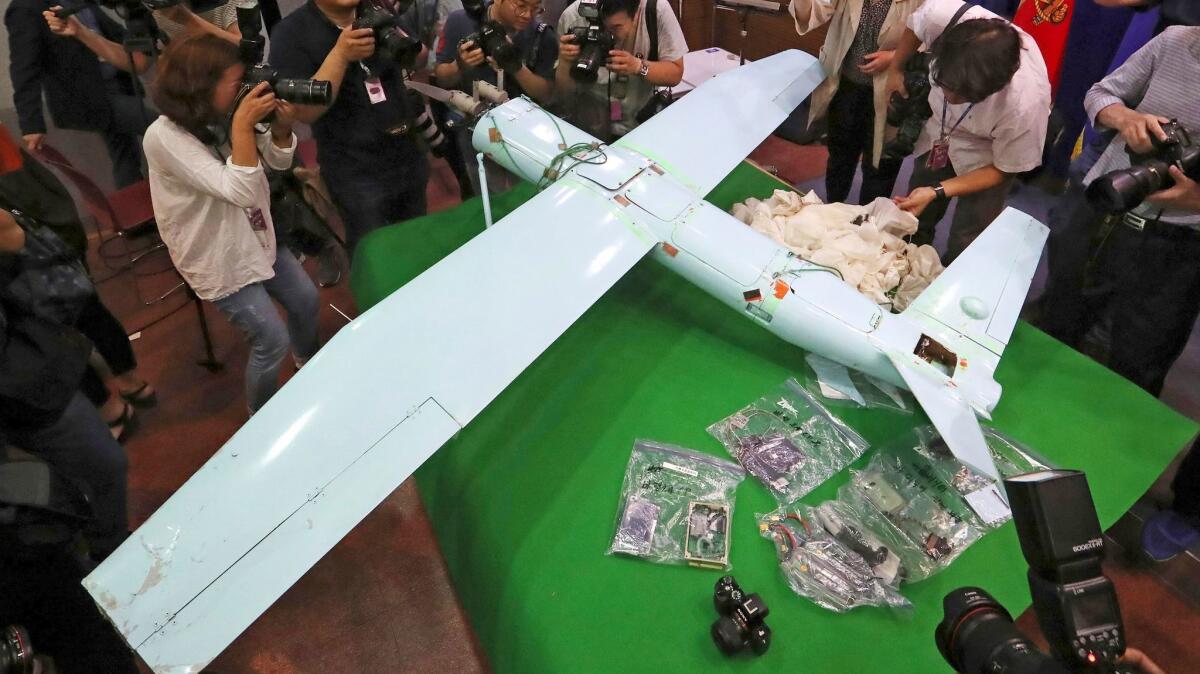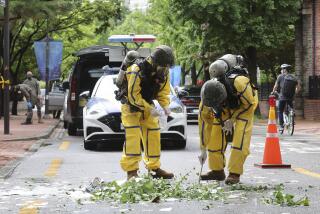As the world focuses on its nuclear ambitions, North Korea deploys another weapon: Drones

The United Nations estimates that North Korea has as many as 300 drones. South Korea considers them a threat.
Earlier this month, a resident in a rural province of South Korea found a small, sky-blue unmanned plane perched nose-up against a tree in a remote forest.
The drone belonged to the North Korean military and apparently had flown south for five hours, capturing images of a sensitive new U.S. anti-missile system before crashing.
It lacked missiles or other weapons like the larger, more advanced models used by U.S. forces in the Middle East. But South Korean officials and security experts consider such flights unlawful incursions.
“It’s a military provocation. It’s an agent spying on a neighboring country’s military information,” Kim Dong-Yub, a professor at Kyungnam University’s Institute for Far Eastern Studies. “It’s the same as sending a spy.”
As world powers focus on North Korea’s emerging nuclear capabilities, its drone program is raising concerns about espionage and aggravating already tense relations with its southern neighbor.
The U.N. estimates that the reclusive state has as many as 300 drones, some of which can fly high and undetected for hundreds of miles.
At least five have been discovered in South Korea since 2014, putting the military on high alert for more. Last month, South Korean soldiers along the border fired 90 machine gun rounds at a suspected drone before concluding it was one of the balloons North Korea uses to drop propaganda leaflets.
North Korea’s capability and intent shouldn’t be a surprise. In a little-noticed display in 2012, the country paraded sky-blue drones with other military systems during in an event commemorating the birthday of Kim Il Sung, the late national patriarch.
Military officials in South Korea think the drone it discovered most recently took off in early May from the North Korean province of Kangwon in the southeastern part of the country. It passed over the highly secured border dividing the two countries — which technically are still at war — before flying south hundreds of miles.
Along the way, it took 550 pictures, including some of a former golf course about 180 miles southeast of Seoul that recently was converted to a military base housing the Terminal High Altitude Area Defense system.
The U.S. missile system, known as THAAD, is designed to stop the North from striking southern parts of South Korea with mid-range missiles. But the powerful radar has provoked objections from China, which retaliated by blocking Chinese tourists from South Korea, restricting access to popular South Korean television programs and closing retail stores belonging to the South Korean conglomerate Lotte Group, which provided the golf course in a land swap with the government.
South Koreans have expressed worries that the system could aggravate regional tensions and that its radar could be a local health hazard. Last weekend, 3,000 people protested outside the American embassy in Seoul.

After spying on the missile system, the drone apparently was headed home when it crashed in Inje County before reaching the border, said Moon Sang-gyun, a Defense Ministry spokesman.
A local resident reported the discovery to the military, sparking widespread media coverage.
Kim Jong-seong, with the Agency for Defense Development, a government research group, said the most-recent plane is similar to one discovered on South Korean soil three years ago.
That model’s wingspan was slightly wider, and it carried a common 35 mm camera. Its engine, which may have failed and caused the crash, appears to have been made in the Czech Republic.
Other drones that have crashed in South Korea have run out of fuel, malfunctioned or veered off course. Their designs have varied, with some resembling sleek, sky-blue stingrays and others shaped like tiny traditional, single-engine planes. Most could fit on a dinner table and resemble those used by hobbyists.
From our perspective, the drones are not very threatening, but from North Korea’s perspective, they have achieved their goal.
— Go Myong-Hyun, Asan Institute for Policy Studies research fellow
The technology discovered in the drones also raise questions about whether some countries are flouting international arms embargoes in place for North Korea. A U.N. panel of experts recently investigated North Korean drone flights and concluded that one likely was made in China.
“The panel inquired with China as to how the vehicle was transferred to the Democratic People’s Republic of Korea, and has yet to receive a reply,” said the report, which uses the formal international name for North Korea.
North Korea doesn’t have a monopoly on drones in the region. The U.S. has 28,000 troops stationed in bases across South Korea, and in March, South Korean officials said they expected the deployment of U.S.-operated Gray Eagle drones to help regional security.
Those drones are roughly 28 feet long with a wingspan double that — far bigger than North Korea’s devices, and far more sophisticated. But the smaller drones have one advantage: They are harder to detect with radar.
Unlike the world’s most advanced drones, which transmit real-time imagery, the one discovered last month used preprogrammed GPS coordinates to set its course, making it unlikely that any images were transmitted back to North Korea, military officials here said.
Such a drone, in theory, could carry an explosive device, although its range presumably would be shortened because of a limited fuel capacity. Still, North Korea had artillery, short-range missiles and other conventional methods of striking population centers in South Korea. Seoul is roughly 35 miles from the border.
The primary concern remains spying. Go Myong-Hyun, a research fellow at Asan Institute for Policy Studies, said detecting and stopping the drones would require an outsized effort.
“North Korea is using an asymmetric strategy,” he said. “From our perspective, the drones are not very threatening, but from North Korea’s perspective, they have achieved their goal. It would cost us a lot to detect the small drones.”
Kim Young-woo, a lawmaker who chairs the defense committee in the South Korean National Assembly, recently called for a special task force to investigate the issue.
“Our airspace has been infiltrated by North Korea,” he said.
What’s the point, the lawmaker asked, of spending roughly $35 billion annually on South Korean defense “when our radar can’t detect small drones?”
Stiles is a special correspondent.
ALSO
South Korea’s president to meet President Trump this week amid grave concerns over North Korea
North Korea is building mysterious artificial islands that would be perfect for missile launches
We went to North Korea. You asked hundreds of questions. Here’s what we found
More to Read
Sign up for Essential California
The most important California stories and recommendations in your inbox every morning.
You may occasionally receive promotional content from the Los Angeles Times.











